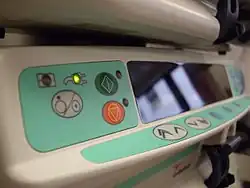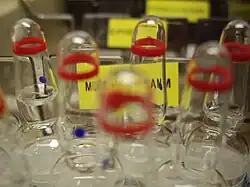Anesthetic technician


An anesthetic technician (US English) or anaesthetic technician (British English) is an allied healthcare worker who performs a patient care role predominantly assisting with the administration and monitoring of anesthesia and has an extensive knowledge of anesthesia techniques, instruments, supplies and technology.
Anesthetic technicians are mainly employed by anesthetic departments or operating theatre suites, but can be found in other areas of clinical practice including emergency departments, intensive care units (ICU) and day surgery clinics.
Role description
Anesthetic technicians are involved with all aspects of the delivery of a patient's perioperative anesthetic care,[1] taking into account the patients' religious and cultural beliefs and respecting their right to medical privacy and dignity at all times. Anesthetic Technicians’ also provide a key role in the emergency resuscitation of patients.
Prior to anesthesia
Anesthetic technicians prepare equipment needed for the patient to safely undergo anesthesia. This involves:
- checking and setting up the anesthetic machine
- preparing intravenous drugs
- preparing intravenous therapy administration equipment
- preparing a range of devices to maintain the patient's airway (e.g. laryngeal masks, endotracheal tube)
- communicating with the patient when they arrive into the operating theatre
- establish peripheral intravenous access.
- applying anesthetic monitoring to help assess the patients' condition whilst under anesthesia. This may include electrocardiography (ECG), blood pressure and oxygen saturation devices. The monitoring of other parameters such as anesthesia depth monitors (EEG, bispectral index etc.) may also be necessary.
During anesthesia
The anesthetic technicians role includes assisting with:
- inducing and maintaining adequate anesthesia.
- establishing and securing an airway.
- making sure that patients are positioned in such a way NOT to cause discomfort or injury during their procedure.
- monitoring and maintaining patients' vital signs and anesthesia depth.
- temperature monitoring and regulation.
- collection and analysis of patient (blood) samples.
- acquiring and administering transfusion fluids and equipment.
After anesthesia
Anesthetic technicians assist the anesthetic with:
- waking the patient.
- removing airway devices.
- transferring patients to post-operative care units
Other activities
Regional variations exist, but anesthetic technicians may also be involved with:
- Airway establishment & management.
- Intra-operative intra-aortic balloon pump setup, operating and monitoring.
- Elective & Emergency Blood Management.
- Swan-Ganz pulmonary artery catheter insertion and monitoring.
- Intra-operative blood salvage setup, operating and monitoring.
- Drawing of blood Samples.
- Arterial blood gas analysis, including maintenance of analysers.
- Arterial line insertion and monitoring.
- Peripheral IV line insertion.
- Cardiopulmonary resuscitation.
- Central IV lines.
- TEG Sampling.
- Point of Care Analysis.
Registered Anaesthetic Technicians in New Zealand
Anaesthetic Technicians work as a member of a multi-disciplinary team that includes doctors, nurses and support workers. The New Zealand Anaesthetic Technicians Society are a body that provides education and support for Anaesthetic Technicians.
Registration
Anaesthetic Technicians are now covered under the Health Practitioners Competence Assurance Act 2003.[2] New Zealand based Anaesthetic assistants must now be registered by law with the Medical Sciences Council of New Zealand (formerly the Medical Laboratory Sciences Board).
In order to practice, members must obtain an Annual Practising Certificate from the Medical Sciences Council.
Qualification
In New Zealand, a Diploma of Applied Science (Anaesthetic Technology)[3] is the national qualification. This is studied for through Auckland University of Technology. Other (international) qualifications may also be acceptable for working as an Anaesthetic Technician in New Zealand.
The amount of practical clinical hours required are laid out by the Australia & New Zealand College of Anaesthetists, professional document PS8.[4]
Anesthetic Technicians in Australia
Registration
Anesthetic Technicians in Australia are provided with voluntary registration of their National Body the Australian Anesthesia Allied Health Practitioners AAAHP.[5] The AAAHP is currently working with the Australian government to introduce Mandatory Regulation. Minimum requirements for Voluntary Registration is completion of the nationally accredited Diploma of Paramedical Science (Anesthesia) or in Western Australia and some hospitals in Victoria Certificate IV in Anesthetic Technology. Currently in Australia Anesthesia Technicians are covered by the Code of conduct for unregistered health professionals, http://www.health.nsw.gov.au/phact/Documents/coc-unregistered-practitioners.pdf .
Health training package
Nationally recognised Diploma in Paramedical Science (Anaethesia) and in Western Australia and some hospitals in Victoria Certificate IV in Anesthetic Technology....
Qualification
- Diploma of Paramedical Science (Anesthesia) - Tafe Queensland Brisbane Queensland www.tafebrisbane.edu.au
- Diploma of Paramedical Science (Anesthesia) - Box Hill Institute
- The recognised minimum qualifications in Western Australia is the Certificate IV in Anesthetic Technology, but this is being phased out as they move towards the Diploma.[6]
Anesthesia Technicians in the United States
In the United States, the American Society of Anesthesia Technologists & Technicians (ASATT), acknowledges the scope of practice for the Anesthesia technical personnel. The commitment of ASATT is to ensure that efficient, safe, competent, and ethical practices are provided to society and maintaining professional standards of practice. ASATT acknowledges that the Anesthesia technical personnel are a part of the Anesthesia care team as listed in the practice guidelines of the American Society of Anesthesiologists (ASA).[7] This position should not be confused with that of an anesthesiologist assistant who actively participates as a licensed anesthesia provider.
Certified Anesthesia Technician
Certified Anesthesia Technologist
Associate & Bachelors Programs
- City College (Florida)
- Grossmont College
- Milwaukee Area Technical College
- North Seattle Community College - Online
- Renton Technical College
- Sanford-Brown Institute - Houston
- Sanford-Brown Institute - Iselin
- Sanford-Brown Institute - Pittsburgh
- Sanford-Brown College - St. Peters
- Skyline College
- Stony Brook University
- Tarrant County College
See also
- Clinical officer anesthetists
- Physician assistant
- Anesthesiologist assistant
- Operating Department Practitioner
References
- ↑ NZATS Scope of Practice
- ↑ Health Practitioners Competence Assurance Act (2003), New Zealand Government
- ↑ Diploma of Applied Sciences (Anaesthetic Technology)
- ↑ ANZCA Professional Document - PS8 Archived April 2, 2012, at the Wayback Machine
- ↑ "Register with AAAHP". Australian Anaesthesia Allied Health Practitioners. Retrieved 30 Sep 2020.
- ↑ WA Qualifications Archived March 23, 2016, at the Wayback Machine
- ↑ "ASATT - Standards of Practice". American Society of Anesthesia Technologists & Technicians. Archived from the original on 2010-10-28. Retrieved 2010-10-27.